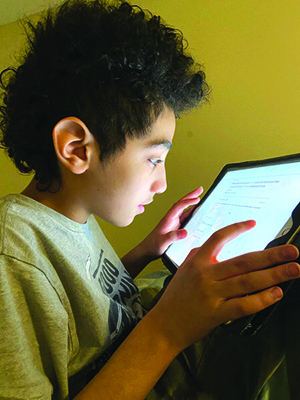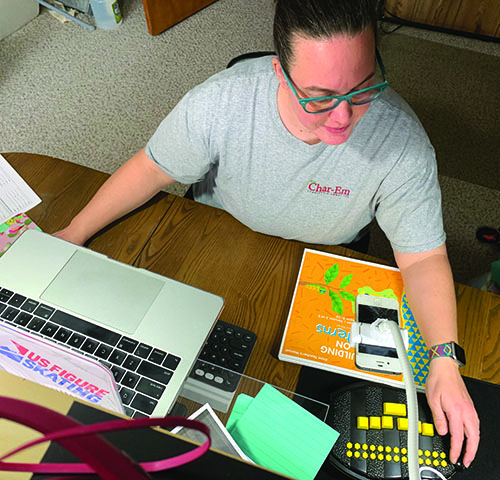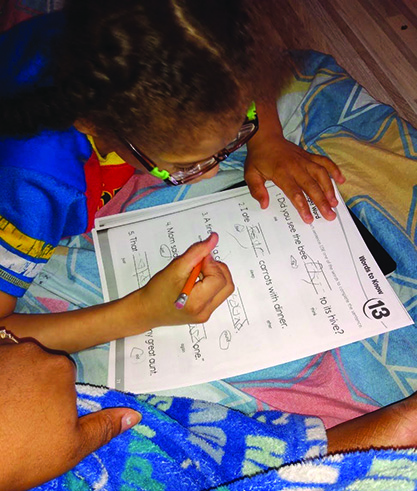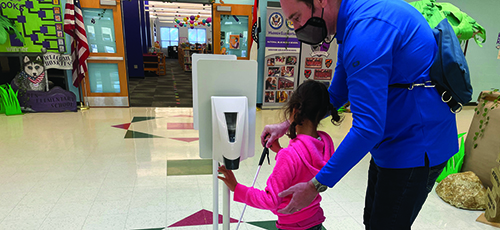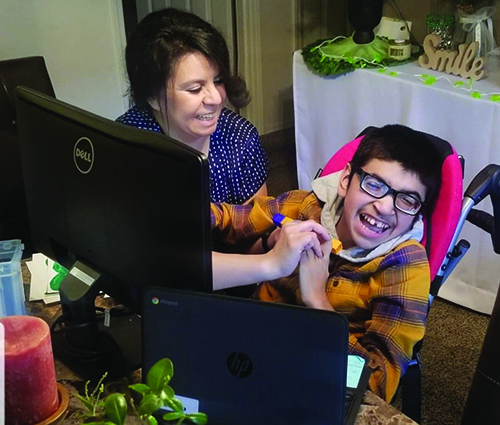I believe that I am still a step behind, but am resourceful and finding the answers I need by asking others and doing research. I can see the pros and cons of what platforms and tech I will continue to use when we go back to in person. By not [not having the option to be in-person], one has to figure this out! —White female TVI
Before the COVID-19 pandemic, in the 2018-2019 school year, there were 56.6 million children in the United States enrolled in school, 50.8 million children in public education, 5.8 million in private schools, and the rest in other settings.8 In Canada in 2018-2019, there were approximately 5.6 million children enrolled in school, with 91.8% of them attending public school.9 School enrollment rates in the United States dropped during the fall semester of the 2020-2021 school year, most notably for children in pre-K and kindergarten. It was estimated that the average school district saw a 16% enrollment drop in kindergarten enrollment.10 The researchers wanted to understand attendance for children whose family members participated in the study. Of the 175 preschool and school-age children, 141 (81%) family members reported that their child/family attends almost all classes or meetings, 29 (17%) reported that they make an effort for their child/family to attend most classes/meetings, but they miss some, and 5 (2%) family members reported it is a struggle for them and/or their child to attend classes/meetings and many are missed. Readers should keep in mind that those family members reporting these data took time to complete a long survey, had Internet access, and may not be representative of the population.
There were 102 (69%) of 148 professionals who reported having at least one family member who declined to have their child attend school in a building.
Many students have learned so much technology through all of this, which is a positive. But those who need more hands-on [instruction] or are unable to do the activities online are losing out on therapies and other related services. —White female TVI
The researchers recognized that across the United States and Canada a range of educational delivery models were being used due to the COVID-19 pandemic. The following six definitions of educational delivery models were used in the survey:
Low-Tech: The TVI and/or O&M specialist does not meet online with the family member and/or student using video such as Zoom or FaceTime. The TVI and/or O&M specialist may use telephone calls, texts, emails, and/or deliver or send materials to the student’s home. The family member may use some apps on a limited basis, if at all.
In Person in the Same Physical Space: The TVI and/or O&M specialist meets in person with the family member and/or student. The TVI and/or O&M specialist may use telephone calls, texts, emails, and/or deliver or send materials to the student’s home. The family member may use some apps.
Online Instruction: The TVI and/or O&M specialist meets online with the family member and/or student. The TVI and/or O&M specialist may use telephone calls, texts, emails, and/or deliver or send materials to the student’s home. The family member may use some apps.
Hybrid Instruction: The TVI and/or O&M specialist meets in person in the same physical space and online with the family member and/or student. The TVI and/or O&M specialist may use telephone calls, texts, emails, and/or deliver or send materials to the student’s home. The family member may use some apps.
Homeschool with No Services from a TVI and/or O&M Specialist: The TVI and/or O&M specialist does not meet with the family member and/or the student. The family member uses an educational curriculum or program they have developed, purchased, and/or received from the school district or state/province.
Homeschool with Services from a TVI and/or O&M Specialist: The TVI and/or O&M specialist meets in person in the same physical space and/or online with the family member and/or student. The family member uses an educational curriculum or program they have developed, purchased, and/or received from the school district or state/province.
Family members of preschool students (n=22) and school-age students (n=168) in addition to the vision professionals were asked a series of questions about educational delivery models.
My child is low tech as she has not been taught screen reading technology, but instead uses a braille notetaker device (Polaris BrailleSense). This has a significant impact because all of the programs our school is using with students are not accessible with this device. She literally only has access to braille and email. —Hispanic female family member of a child who is blind with additional disabilities, 13 to 15 years old
Low-Tech Education
There were 9 children whose family members reported they were receiving education through a low-tech delivery model. Five of the children were receiving either TVI and/or O&M services. Family members reported that children had low-tech options for accessing print, such as a dome magnifier and large print. Overwhelmingly, the 9 family members wanted their children to receive in-person instruction since the children were not successful with an online model.
In-Person Education
There were 70 children whose family members reported they were receiving full-time in-person education. Other children were receiving in-person education as part of a hybrid model.
Whether a fully in-person, hybrid, or homeschool delivery model was being used, the researchers wanted to understand how in-person education was being delivered during the pandemic. Ninety-six family members of preschool and school-age children were asked to select all the ways in-person education was currently occurring for their child. These included meetings:
Inside a school or other professional building (n=82)
In a public outdoor space, for example, at the park or on the playground at the school (n=19)
Outside of the home, for example, on the porch or in the backyard (n=10)
Inside the home (n=6)
Eighty-six family members of preschool and school-age children reported the number of days their child currently attended school in a building. Six (7%) of 86 students attended one day a week, 12 (14%) attended two days a week, 5 (6%) attended three days a week, 12 (14%) attended four days a week, and 51 (59%) attended five days a week.
Family members of preschool and school-age students were asked to select their level of agreement with the statement: I believe the benefits of my child working with the TVI and/or O&M specialist in person, given the current levels of safety precautions and protections in place, outweigh the risks of potential exposure to COVID-19 for my child. Of the 97 family members who responded, the mean was 3.3 (SD=1.0)11. The level of agreement participants had with this statement fell between “Agree” and “Strongly agree.”
Family members of preschool and school-age students were asked to select their level of agreement with the statement: I believe the benefits of my child working with the TVI and/or O&M specialist in person, given the current levels of safety precautions and protections in place, outweigh the risks of potential exposure to COVID-19 for me or others who have regular contact with my child. Of the 97 family members who responded, the mean was 3.3 (SD=1.1).12 The level of agreement participants had with this statement fell between “Agree” and “Strongly agree.”
Over three-quarters (n=357, 77%) of 465 vision professionals reported they had students going into buildings to receive educational services. When asked if they had a choice about serving students receiving education in buildings, 358 professionals answered the question, with 112 (31%) reporting they did have a choice, 195 (54%) reporting they did not have a choice, and 51 (14%) unsure if the choice was theirs. Fifty-five professionals who had students receiving some or all of their education in buildings reported that there was at least one building they were not permitted to enter to provide service. In these cases, vision professionals had to use alternative methods to serve students. These included relying on other educational team members or family members to deliver instruction, meeting outdoors with students, or designing simplified lessons family members could carry out.
Vision professionals were asked to select their level of agreement with the statement: Given current school and district policies and procedures, I am comfortable providing in-person instruction for all the districts I serve where in-person instruction is allowed. Of the 453 vision professionals who responded, the mean was 2.54 (SD=0.94).13 The level of agreement participants had with this statement fell between “Disagree” and “Agree.”
I am a retired TVI who is currently working full time as a ‘remote’ TVI. I meet daily with my students via remote access. Four are in schools, the fifth is in their home. I connect via Zoom. My students have an acrylic tabletop shelf where they put their device, I can then view their work through the device camera. I can see directly their brailling or work below the tabletop. Some student[s] use two devices, both logged in with Zoom, and this enables me to see their brailling and their math window work. The clarity of viewing is excellent and has allowed the lessons to be highly successful. —Female TVI
Safety
Each district has a different way of screening when I arrive and there is little consistency on that screening. Because we itinerants run from building to building with little wiggle room, I miss several minutes of each session with some of my students because the screening takes so long and changes at will. [I am] using an app one day then having the nurse or security person check me in another day, etc. —Multiracial female TVI
During the pandemic, safety is a concern for both family members and vision professionals when in-person education occurs. Family members of preschool and school-age students were asked about the frequency they, the TVI, and/or the O&M specialist were using COVID-19 safety precautions when meeting in person. As expected, use of safety precautions was high. Ninety-nine (94%) of 105 family members reported they always used COVID-19 safety precautions. Thirty-four (90%) of 36 family members reported the TVI always used COVID-19 safety precautions, and 71 (88%) of 81 family members reported the O&M specialist always used COVID-19 safety precautions. Family members of school-age children were asked about their child’s adherence to COVID-19 safety precautions. Of the 105 children receiving in-person education, 11 (10%) children did not understand the importance of safety precautions, 84 (80%) children used safety precautions all the time, 6 (6%) most of the time, 2 (2%) some of the time, and 2 (2%) hardly ever.
The professionals were provided a list of ways they may use to maintain their safety. There were 425 professionals who indicated that they did at least one of the following:
Wore a mask (n=370)
Requested that all adults wear a mask (n=237)
Requested that whenever possible students wear a mask (n=280)
Maintained 6 feet or more distance (n=172)
Only met with students and/or their family members when an activity/service had to be done in person in the same physical space (n=97)
Wore a face shield (n=72)
Refrained from meeting indoors with students and/or their family members (n=71)
Wore gloves (n=56)
Restricted the length of in-person meetings (n=53)
Wore protective clothing (n=33)
Professionals were asked to select their level of agreement with the statement: Given current school and district policies and procedures, I am comfortable providing in-person instruction for all the districts I serve where in-person instruction is allowed. Of the 453 professionals who responded, the mean was 2.55 (SD=0.94).14 The level of agreement participants had with this statement fell between “Disagree” and “Agree.”
Online Education
Low vision students are using their tools more proficiently (low vision and auditory access) and are not struggling as much to "see the board" [when online]. Their access is very dependent on the quality of the instructional media that are posted digitally, and on how well the classroom teacher understands how to screenshare the best possible images. —Asian female dually certified professional
There were 57 preschool and school-age students whose family members reported they were receiving online education. Family members were asked if they electronically received lessons, assignments, or activities from any of their child’s teachers or therapists. Of 171 family members, 108 (63%) reported they did. Yet 115 family members reported on how frequently they received these items, with 29 (25%) family members reporting 1-2 times a week, 10 (9%) 3-4 times a week, 19 (17%) 5-6 times a week, 21 (18%) 7 or more times a week, and 36 (31%) indicating it varied. Sixty-nine family members reported they were asked to send evidence showing their child had completed the work.
Family members were asked how many hours a week they or their child met online with the TVI. Of the 36 family members who reported online meetings, 13 (36%) reported meeting 1-3 hours a week, 7 (19%) 4-6 hours a week, 4 (11%) 10 or more hours a week, and 12 (33%) reported the number of hours varied. Due to an error with the survey, the amount of online meeting time with the O&M specialist was not captured. Seventy-four family members reported their child and/or family members met online with regular or special education teachers.
Sixty-four (41%) of 155 professionals reported that they had students they were meeting with online who were also attending school in a building.
Professionals were asked to select their level of agreement with the statement: I am comfortable providing online instruction. Of the 457 professionals who responded, the mean was 2.87 (SD=0.72).15 The level of agreement participants had with this statement fell between “Disagree” and “Agree” but was close to “Agree.”
The researchers wanted to understand what platforms professionals were asked to use for online meetings with students and/or family members. Of the 440 professionals who selected at least one platform, 324 used Zoom, 217 Google Meet, 70 FaceTime, 70 Microsoft Teams, 30 Canvas, 23 Google Hangout, 14 Seesaw, 14 WebEx, and 11 Team Viewer.
Professionals and family members reported challenges with online meeting platforms including low Internet bandwidth resulting in lags or missed instruction, issues with accessibility for students using screen readers, content shared by teachers that was not accessible to students, difficulty or inability of students with low vision to see the screen, and lack of motivation or connection for some students with instruction delivered in this format.
Hybrid Education
I have been fortunate to see many students at their homes which has been wonderful to address their neighborhoods vs school surroundings. Parents seem more involved and learning what their children are capable of doing in O&M. Parents can be inconsistent with schedules and need more reminders for home visits than I have time to provide, but I do text prompts and reminders now. Online learning is limited, and I have two students who do not speak English and their families do not also, so I have been creative, finding online videos to teach orientation concepts in native languages to allow parents to participate and assist with learning concepts of orientation. Of course, there is always a technology glitch. —White female O&M specialist
There were 24 preschool and school-age children whose family members reported they were receiving education through a hybrid delivery model which combined in-person and online educational delivery.
Professionals were asked if they had designated days/times when they provided in-person instruction and days/times when they provided online instruction. Of the 364 professionals providing hybrid instruction, a third (n=125, 34%) had a set schedule, 69 (19%) were attempting to have a set schedule, 89 (25%) reported that most days they worked with a combination of online and in-person learners, and 81 (22%) reported they lacked a set schedule.
Homeschool Education
Six family members reported their child was being homeschooled, with four families homeschooling before the pandemic. All but one homeschooled child was receiving services from a TVI and/or O&M specialist. Most frequently, family members reported their children used laptops, smartphones, and canes. Family members reported that a challenge of the homeschool educational model was the lack of social interaction for their child.
We are new to the homeschooling option but based on our experience, we are better off. The young childlike treatment and low expectations of the school were enough to drive us mad. We are providing the tools to access the world, and this is a huge benefit to our daughter. The support from caring and competent TVI and O&M [specialist] would be nice but not necessary as we truly believe we are on a good trajectory as parents. —White male family member of a child who has low vision with additional disabilities, 13 to 15 years old
8. TK-12 Enrollment Statistics [2021]: Totals by Grade Level + More. *EducationData. *Accessed March 12, 2021. https://educationdata.org/k12-enrollment-statistics
9. Government of Canada SC. *The Daily — Vast majority of students attended public schools prior to the pandemic. *Published October 15, 2020. Accessed March 12, 2021. https://www150.statcan.gc.ca/n1/daily-quotidien/201015/dq201015a-eng.htm
10. Enrollment Is Dropping in Public Schools Around the Country. NPR.org. Accessed March 12, 2021. http://www.npr.org/2020/10/09/920316481/enrollment-is-dropping-in-public-schools-around-the-country
11. The mean (M) is derived by averaging the participants’ ratings—from "Strongly disagree” (1) to “Strongly agree” (4). The larger the standard deviation (SD), the greater the spread from the mean of the participants’ ratings.
12. The mean (M) is derived by averaging the participants’ ratings—from "Strongly disagree” (1) to “Strongly agree” (4). The larger the standard deviation (SD), the greater the spread from the mean of the participants’ ratings.
13. The mean (M) is derived by averaging the participants’ ratings—from “Strongly disagree” (1) to “Strongly agree” (4). The larger the standard deviation (SD), the greater the spread from the mean of the participants’ ratings.
14. The mean (M) is derived by averaging the participants’ ratings—from “Strongly disagree” (1) to “Strongly agree” (4). The larger the standard deviation (SD), the greater the spread from the mean of the participants’ ratings.
15. The mean (M) is derived by averaging the participants’ ratings—from “Strongly disagree” (1) to “Strongly agree” (4). The larger the standard deviation (SD), the greater the spread from the mean of the participants’ ratings.
